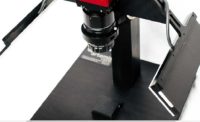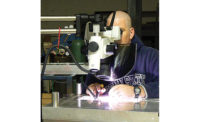Well known for its engineering expertise, The EDAG Group develops vehicles and production systems for auto manufacturers all over the world. In conjunction with FFT EDAG, its sister company, The EDAG Group also creates complete production facilities for body in white modeling and vehicle assembly.
The company is headquartered in Fulda, Germany, and its U.S. operations are based in Detroit. More than 5,500 people work for EDAG worldwide.
Recently, the company was hired by BMW to develop a small-lot welding system for one of its plants in Europe. The system requires a rotary table with an open center and a high load capacity. Within the center sits a heavy-duty robot that performs the welding. On the outer edge are four tooling sections, each of which weighs up to 4 tons and holds parts as they are welded.
During system development, EDAG researched several rotary tables. Unfortunately, none of them were strong enough to bear 16 tons. This situation convinced Manfred Hahl, managing director and COO for The EDAG Group, to have the company develop the system in conjunction with rotary table and automation specialist Weiss GmbH.
After extensive discussions, Weiss agreed to make a customized rotary table based on the company’s CR 2600 series. Developed within six months, the table has a 20-ton capacity. The center opening is 2 meters in diameter, which is large enough to accommodate a robot with a 2.5-meter reach.
The table’s drive plate can withstand a vertical dynamic force of 500 kilonewtons and a static force of 1,000 kilonewtons. With a low installation height (300 millimeters), the table allows for ergonomic manual or automated loading of the part.
Weiss Application Software (WAS) ensures fast setup and uncomplicated integration into all production cycles. Other features include a freely programmable drive, zero backlash, optimum power transmission and a drive unit that can be easily operated with WAS.
The table also features a specially designed YRT bearing, which is a combination of two axial bearings and a radial bearing.
Currently, BMW is using two of the tooling sections (A and C) to weld rear hatches and hoods. To begin production, the worker loads a workpiece to be welded into section A. The table is rotated 180 degrees, and the robot makes welds on the top and bottom of this workpiece.
Simultaneously, the worker loads a workpiece to be welded into tooling section C. When the workpiece in section A is finished, the table is rotated 180 degrees so the workpiece in section C is ready to be welded and the finished piece is removed from section A.
Thus far, BMW has used one large robot with the rotary table. However, Hahl says the automaker likes that the table’s opening can accommodate two or more small robots. BMW also likes that the table enables welding of four different door types in small lots.
For more information on rotary indexing tables, call 888-934-7762 or visit www.weissna.com.



